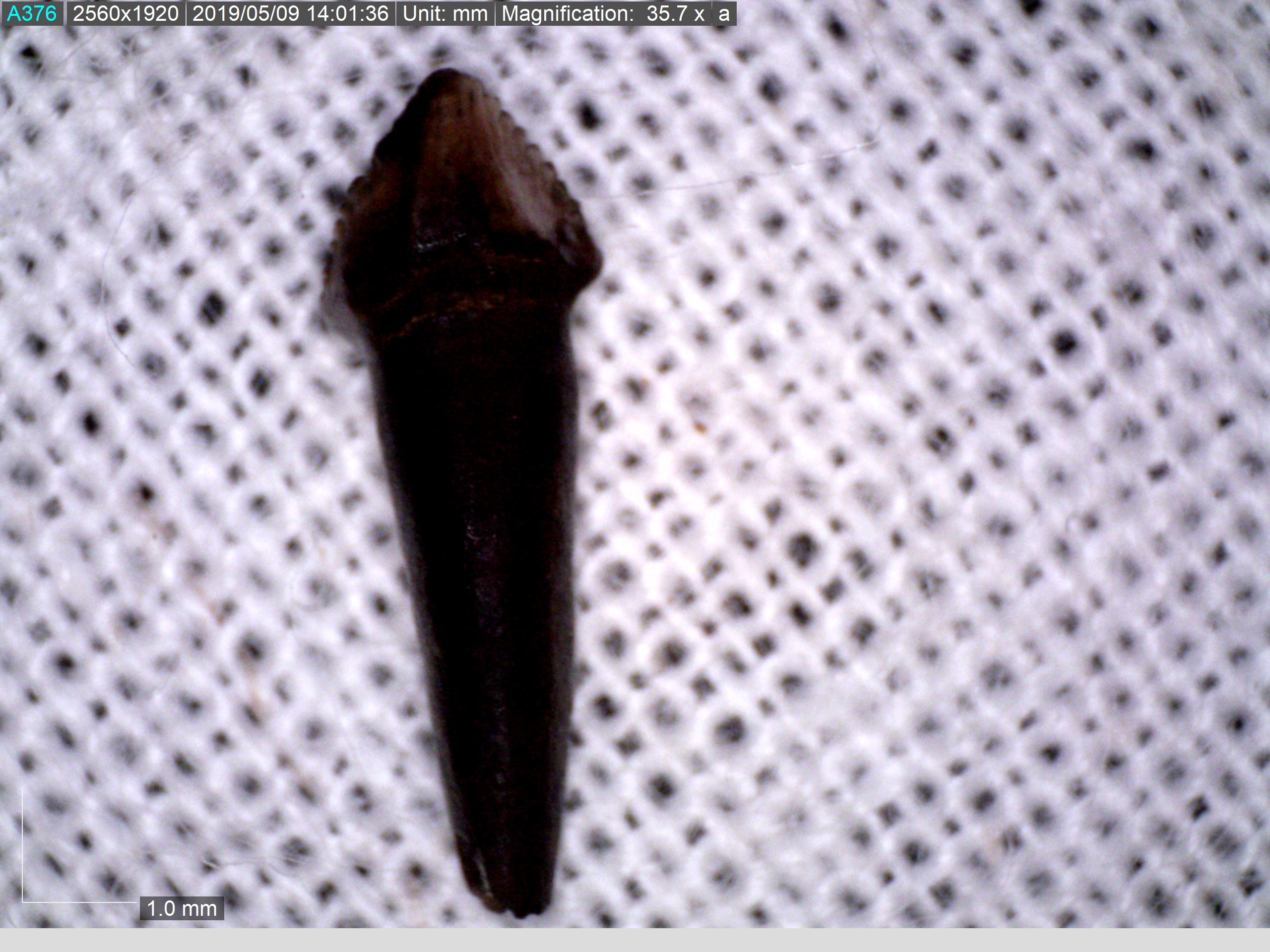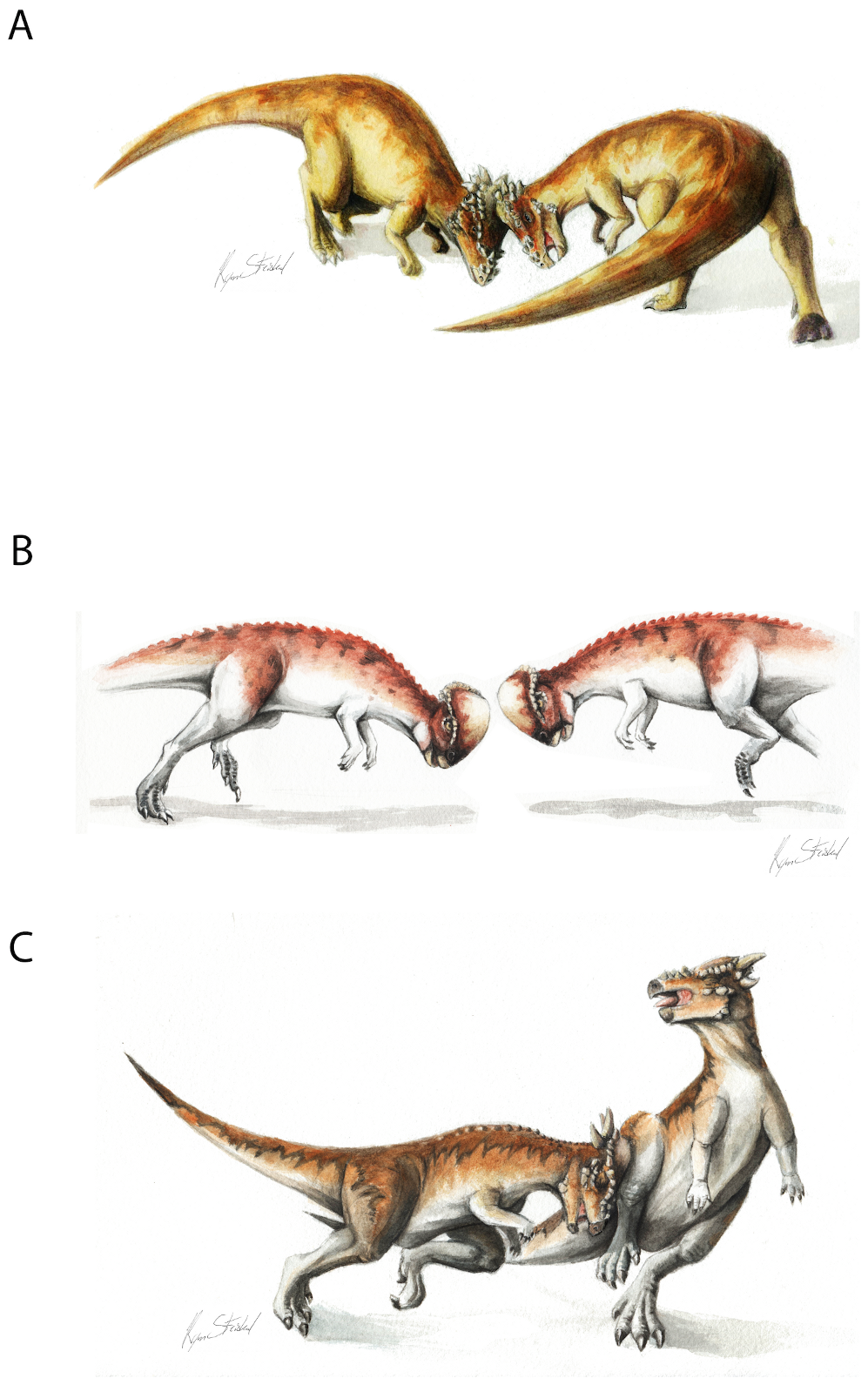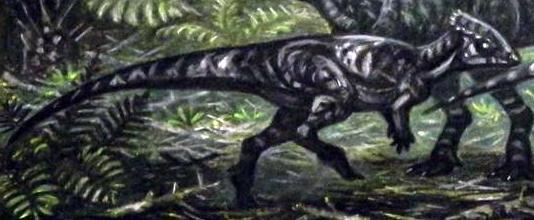|
Alaskacephale
''Alaskacephale'' was a genus of pachycephalosaurid dinosaur from the Prince Creek Formation, that lived in the early Maastrichtian stages of the Late Cretaceous (around 71 to 69 million years ago). Discovery ''Alaskacephale'' was named by Robert Sullivan in 2006. The genus name refers to Alaska, where the holotype was discovered, combined with the Greek ''kephale'', meaning head. The species name, ''gangloffi'', honors paleontologist Roland Gangloff. The only known specimen of ''A. gangloffi'' is the holotype UAM AK-493-V-001, found in 1999, a nearly complete left squamosal with a characteristic array of polygonal nodes. The dimensions of this bone suggest that ''A. gangloffi'' was about half the size of ''Pachycephalosaurus wyomingensis'' or three quarters the size of ''Prenocephale'', and about the same size as '' Sphaerotholus edmontonensis'' and ''Foraminacephale''. The specimen was previously described by Gangloff ''et al.'' (2005) as an unnamed pachycephalosaurid, possibl ... [...More Info...] [...Related Items...] OR: [Wikipedia] [Google] [Baidu] |
Pachycephalosauria
Pachycephalosauria (; from Greek παχυκεφαλόσαυρος for 'thick headed lizards') is a clade of ornithischian dinosaurs. Along with Ceratopsia, it makes up the clade Marginocephalia. With the exception of two species, most pachycephalosaurs lived during the Late Cretaceous Period, dating between about 85.8 and 65.5 million years ago. They are exclusive to the Northern Hemisphere, all of them being found in North America and Asia. They were all bipedal, herbivorous/omnivorous animals with thick skulls. Skulls can be domed, flat, or wedge-shaped depending on the species, and are all heavily ossified. The domes were often surrounded by nodes and/or spikes. Partial skeletons have been found of several pachycephalosaur species, but to date no complete skeletons have been discovered. Often isolated skull fragments are the only bones that are found. Candidates for the earliest known pachycephalosaur include ''Ferganocephale adenticulatum'' from Middle Jurassic Period strata ... [...More Info...] [...Related Items...] OR: [Wikipedia] [Google] [Baidu] |
Pachycephalosaurid
Pachycephalosauria (; from Greek παχυκεφαλόσαυρος for 'thick headed lizards') is a clade of ornithischian dinosaurs. Along with Ceratopsia, it makes up the clade Marginocephalia. With the exception of two species, most pachycephalosaurs lived during the Late Cretaceous Period, dating between about 85.8 and 65.5 million years ago. They are exclusive to the Northern Hemisphere, all of them being found in North America and Asia. They were all bipedal, herbivorous/omnivorous animals with thick skulls. Skulls can be domed, flat, or wedge-shaped depending on the species, and are all heavily ossified. The domes were often surrounded by nodes and/or spikes. Partial skeletons have been found of several pachycephalosaur species, but to date no complete skeletons have been discovered. Often isolated skull fragments are the only bones that are found. Candidates for the earliest known pachycephalosaur include ''Ferganocephale adenticulatum'' from Middle Jurassic Period strata ... [...More Info...] [...Related Items...] OR: [Wikipedia] [Google] [Baidu] |
2006 In Paleontology
Plants Ferns and fern allies Angiosperms Arthropods Insects Tetrapodomorphs Amphibians Newly named temnospondylians Newly named amphibians Ichthyosaurs Lepidosauromorphs Newly named basal lepidosauromorphs Newly named plesiosaurs Newly named squamates Turtles Archosauromorphs Newly named crurotarsans Newly named dinosaurs * Vickaryous, M K., 2006, New information on the cranial anatomy of Edmontonia rugosidens Gilmore, a Late Cretaceous nodosaurid dinosaur from Dinosaur Provincial Park, Alberta: JVP, v. 26, n. 4: 1011–1013. Data are courtesy of George Olshevky's dinosaur genera list. Newly named birds Newly named pterosaurs Synapsids Non-mammalian Mammals Trace fossils * The trace fossil genera ''Nihilichnus'' (''Nihilichnus nihilicus'' and ''Nihilichnus mortalis''), ''Machichnus'' (''Machichnus regularis,'' ''Machichnus multilineatus'', and ''Machichnus bohemicus'') and ''Brutalichnus'' (''Brutalichnus'' ''brutalis'') are described fr ... [...More Info...] [...Related Items...] OR: [Wikipedia] [Google] [Baidu] |
Pachycephalosaurus
''Pachycephalosaurus'' (; meaning "thick-headed lizard", from Greek ''pachys-/'' "thick", ''kephale/'' "head" and ''sauros/'' "lizard") is a genus of pachycephalosaurid dinosaurs. The type species, ''P. wyomingensis'', is the only known species, but some researchers argue that there might be a second species, ''P. spinifer''. It lived during the Late Cretaceous Period (Maastrichtian stage) of what is now North America. Remains have been excavated in Montana, South Dakota, Wyoming, and Alberta. It was a herbivorous creature which is primarily known from a single skull and a few extremely thick skull roofs, at 22 centimetres (9 inches) thick. More complete fossils have been found in recent years. ''Pachycephalosaurus'' was among the last non-avian dinosaurs before the Cretaceous–Paleogene extinction event. The genus ''Tylosteus'' has been synonymized with ''Pachycephalosaurus'', as have the genera ''Stygimoloch'' and ''Dracorex'' in recent studies. Like other pachycephalosaurids ... [...More Info...] [...Related Items...] OR: [Wikipedia] [Google] [Baidu] |
Pachycephalosaurus Wyomingensis
''Pachycephalosaurus'' (; meaning "thick-headed lizard", from Greek ''pachys-/'' "thick", ''kephale/'' "head" and ''sauros/'' "lizard") is a genus of pachycephalosaurid dinosaurs. The type species, ''P. wyomingensis'', is the only known species, but some researchers argue that there might be a second species, ''P. spinifer''. It lived during the Late Cretaceous Period (Maastrichtian stage) of what is now North America. Remains have been excavated in Montana, South Dakota, Wyoming, and Alberta. It was a herbivorous creature which is primarily known from a single skull and a few extremely thick skull roofs, at 22 centimetres (9 inches) thick. More complete fossils have been found in recent years. ''Pachycephalosaurus'' was among the last non-avian dinosaurs before the Cretaceous–Paleogene extinction event. The genus ''Tylosteus'' has been synonymized with ''Pachycephalosaurus'', as have the genera ''Stygimoloch'' and ''Dracorex'' in recent studies. Like other pachycephalosaurids ... [...More Info...] [...Related Items...] OR: [Wikipedia] [Google] [Baidu] |
Pachycephalosaurini
Pachycephalosauria (; from Greek παχυκεφαλόσαυρος for 'thick headed lizards') is a clade of ornithischian dinosaurs. Along with Ceratopsia, it makes up the clade Marginocephalia. With the exception of two species, most pachycephalosaurs lived during the Late Cretaceous Period, dating between about 85.8 and 65.5 million years ago. They are exclusive to the Northern Hemisphere, all of them being found in North America and Asia. They were all bipedal, herbivorous/omnivorous animals with thick skulls. Skulls can be domed, flat, or wedge-shaped depending on the species, and are all heavily ossified. The domes were often surrounded by nodes and/or spikes. Partial skeletons have been found of several pachycephalosaur species, but to date no complete skeletons have been discovered. Often isolated skull fragments are the only bones that are found. Candidates for the earliest known pachycephalosaur include ''Ferganocephale adenticulatum'' from Middle Jurassic Period strata ... [...More Info...] [...Related Items...] OR: [Wikipedia] [Google] [Baidu] |
Stegoceras Validum
''Stegoceras'' is a genus of pachycephalosaurid (dome-headed) dinosaur that lived in what is now North America during the Late Cretaceous period, about 77.5 to 74 million years ago (mya). The first specimens from Alberta, Canada, were described in 1902, and the type species ''Stegoceras validum'' was based on these remains. The generic name means "horn roof", and the specific name means "strong". Several other species have been placed in the genus over the years, but these have since been moved to other genera or deemed junior synonyms. Currently only ''S. validum'' and ''S. novomexicanum'', named in 2011 from fossils found in New Mexico, remain. The validity of the latter species has also been debated. ''Stegoceras'' was a small, bipedal dinosaur about long, and weighed around . The skull was roughly triangular with a short snout, and had a thick, broad, and relatively smooth dome on the top. The back of the skull had a thick "shelf" over the occiput, and it had a thick ridge ... [...More Info...] [...Related Items...] OR: [Wikipedia] [Google] [Baidu] |
Foraminacephale
''Foraminacephale'' (meaning "foramina head") is a genus of pachycephalosaurid dinosaur from Late Cretaceous (Campanian stage) deposits of Canada. Description ''Foraminacephale'', as a pachycephalosaurid, was a small, bipedal herbivore with a thickened dome on its skull. In 2016, Gregory S. Paul estimated its length at , its weight at . In ''Foraminacephale'', the top surface of the dome is punctuated by many small pits, the eponymous foramina; the dome itself consists of a large, central lobe with a sloped frontal half, and two smaller lateral lobes at the front. The squamosal bone forms a tall bar of completely smooth bone underneath the dome, save for six bony nodes that line the bottom edge of the dome and an additional "corner" node just below. These features differentiate ''Foraminacephale'' from all other pachycephalosaurids. Unlike ''Stegoceras'', ''Hanssuesia'', and '' Colepiocephale'', the parietal bone of ''Foraminacephale'' (which constitutes the back part of the dom ... [...More Info...] [...Related Items...] OR: [Wikipedia] [Google] [Baidu] |
Stegoceras Novomexicanum
''Stegoceras'' is a genus of pachycephalosaurid (dome-headed) dinosaur that lived in what is now North America during the Late Cretaceous period, about 77.5 to 74 million years ago (mya). The first specimens from Alberta, Canada, were described in 1902, and the type species ''Stegoceras validum'' was based on these remains. The generic name means "horn roof", and the specific name means "strong". Several other species have been placed in the genus over the years, but these have since been moved to other genera or deemed junior synonyms. Currently only ''S. validum'' and ''S. novomexicanum'', named in 2011 from fossils found in New Mexico, remain. The validity of the latter species has also been debated. ''Stegoceras'' was a small, bipedal dinosaur about long, and weighed around . The skull was roughly triangular with a short snout, and had a thick, broad, and relatively smooth dome on the top. The back of the skull had a thick "shelf" over the occiput, and it had a thick ridge ... [...More Info...] [...Related Items...] OR: [Wikipedia] [Google] [Baidu] |
Prince Creek Formation
The Prince Creek Formation is a geological formation in Alaska with strata dating to the Early Maastrichtian stage of the Late Cretaceous. Dinosaur remains are among the fossils that have been recovered from the formation.Weishampel, David B; et al. (2004). "Dinosaur distribution (Late Cretaceous, North America)." In: Weishampel, David B.; Dodson, Peter; and Osmólska, Halszka (eds.): The Dinosauria, 2nd, Berkeley: University of California Press. Pp. 574-588. . Age The Prince Creek Formation aged from 80 to 61.7 million years ago. The Kikak-Tegoseak Quarry, where almost all of the dinosaur fossil are from, is located near the middle of the formation, and is about 70.6 to 69.1 million years ago. A lower section, the Kogosukruk Tongue, ages from 72 to 71 million years ago, in the latest Campanian. The youngest part of the formation is Ocean Point, which extends into the Paleogene, at the end of the Danian, based on the age of ostracods and mollusks. In the middle of the formation i ... [...More Info...] [...Related Items...] OR: [Wikipedia] [Google] [Baidu] |
Foraminacephale Brevis
''Foraminacephale'' (meaning "foramina head") is a genus of pachycephalosaurid dinosaur from Late Cretaceous (Campanian stage) deposits of Canada. Description ''Foraminacephale'', as a pachycephalosaurid, was a small, bipedal herbivore with a thickened dome on its skull. In 2016, Gregory S. Paul estimated its length at , its weight at . In ''Foraminacephale'', the top surface of the dome is punctuated by many small pits, the eponymous foramina; the dome itself consists of a large, central lobe with a sloped frontal half, and two smaller lateral lobes at the front. The squamosal bone forms a tall bar of completely smooth bone underneath the dome, save for six bony nodes that line the bottom edge of the dome and an additional "corner" node just below. These features differentiate ''Foraminacephale'' from all other pachycephalosaurids. Unlike ''Stegoceras'', ''Hanssuesia'', and '' Colepiocephale'', the parietal bone of ''Foraminacephale'' (which constitutes the back part of the dom ... [...More Info...] [...Related Items...] OR: [Wikipedia] [Google] [Baidu] |
Goyocephale Lattimorei
''Goyocephale'' is an extinct genus of pachycephalosaurian ornithischian that lived in Mongolia during the Late Cretaceous about 76 million years ago. It was first described in 1982 by Altangerel Perle, Teresa Maryańska and Halszka Osmólska for a disarticulated skeleton with most of a skull, part of the forelimb and hindlimb, some of the pelvic girdle, and some vertebrae. Perle ''et al.'' named the remains ''Goyocephale lattimorei'', from the Mongolian гоё (''goyo''), meaning "decorated", and the Ancient Greek κεφαλή (''kephale''), for head. The species name honours Owen Lattimore. Description ''Goyocephale'' is known from a partial skull, including both mandibles, the skull roof, part of the occiput, part of the braincase region, the posterior skull, the premaxilla, and the maxilla. The posterior edge of the skull roof, at the edge of the squamosal bones, has many small bony bumps, which would have been the base of small horns in life. A feature shared with pachyc ... [...More Info...] [...Related Items...] OR: [Wikipedia] [Google] [Baidu] |



.jpg)





